With the League Two season have gone halfway through the first stage, the league table was left without a distinctive gap between the promotion-chasers and the mid-table teams. The distance between the leader Forest Green Rovers and their chasers in Bradford City, Swindon Town and Crewe Alexandra was only one point. At the same time, they were only separated with the twelveth and thirteenth-placed Cambridge United and Plymouth Argyle by just eight points, which left the race to the promotion-chasing group wide open.
Among the matches that weren’t postponed due to international duties last weekend, Swindon’s trip to Salford City’s Peninsula Stadium really caught the eyes of the fans. As mentioned, Swindon were one point off the top spot and with the strong form of three wins and one draw in their last five matches, they were heading close to their hope of returning to League One. On the opposite side, Salford are enjoying their first season in the Football League system and have had a strong start to it. With 24 points after seventeen matches, the promotion hopes all of a sudden became a reality for them.
That strong run came to a halt as they fell short against Swindon in a game where Salford’s Adam Rooney scored a brace from the penalty spot but didn’t manage to help his team came out on top. This tactical analysis will provide an analysis of Swindon’s 3-2 win over Salford. Meanwhile, using statistics, we will point out what went wrong with Graham Alexander’s tactics against Richie Wellens’ tactics.
Lineups
Salford entered this match with a little twist to their formation in the previous match against Tranmere Rovers in the EFL Trophy. From a 3-5-2 formation, Alexander switched to a 4-4-2 that was implemented in recent weeks. Among the players who missed out through injuries, loanee Jack Baldwin’s service would be missed as Liam Hogan was chosen to fill into his position.
At the same time, goalkeeper Kyle Letheren was also absented from the squad list with Chris Neal returned to the number one spot and the former York goalkeeper was registered on the bench. Ibou Touray hoped to continue his strong run to the season at left-back with the form that helped him secured two goals, three assists along with a 7.18 rating from WhoScored.
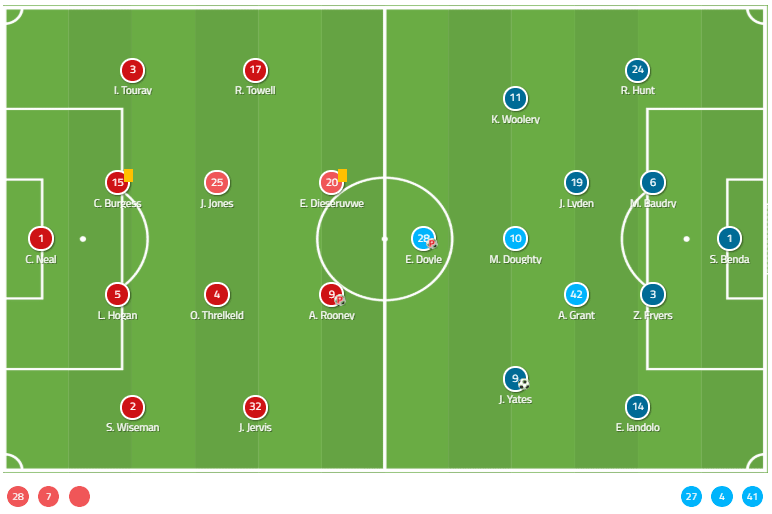
On the opposite side, Swindon also saw their formation being switched from a 3-5-2 to their familiar 4-2-3-1 formation. At the heart of their defence, Wellens didn’t have the service of Dion Conroy on his books as he missed out through injury. Also saw their names weren’t included in the squad list were Lloyd Isgrove and Cameron McGlip as they were recovering from their respective injuries.
In contrast, Rob Hunt managed to shake off his injury problem to complete the team’s back-four that already consisted of centre-backs Mathieu Baudry, Zeki Fryers and left-back Ellis Iandolo. Danny Rose also made the substitutes alongside Norwich loanee Diallang Jaiyesimi and former Birmingham defender Paul Caddis. The team’s main goal-providers would still be their attacking midfielder trio of Jerry Yates, Michael Doughty and Kaiyne Woolery and they provided the support for Eoin Doyle.
A tepid first-half from both sides
Approaching this match after a strong run that saw them secured three wins and a draw, it was no surprise to see them playing with high confidence. When in possession, Salford players tended to play out from the back. While both full-backs usually pushed higher up the pitch and positioned themselves in an attacking position, two central midfielders would stay back and create a passing block along with Cameron Burgess and Liam Hogan.
The aim was to circulate the ball among the passing block and allowed their teammates upfront to pick out pockets of space where they could position themselves into. This was when one of the players would carry the ball up the pitch and Joey Jones was the one who responsible for this. He brought the ball out of defence through his dribbling and then connected with the attackers to continue the team’s attack. At times, his partner, Oscar Threlkeld could also take on his responsibility. Moving slightly away from his preferred position, which was a right-back, the former Bolton defender had the duties of screening the space in front of the defensive line while also linking up the defenders with the midfielders in transitioning scenarios.
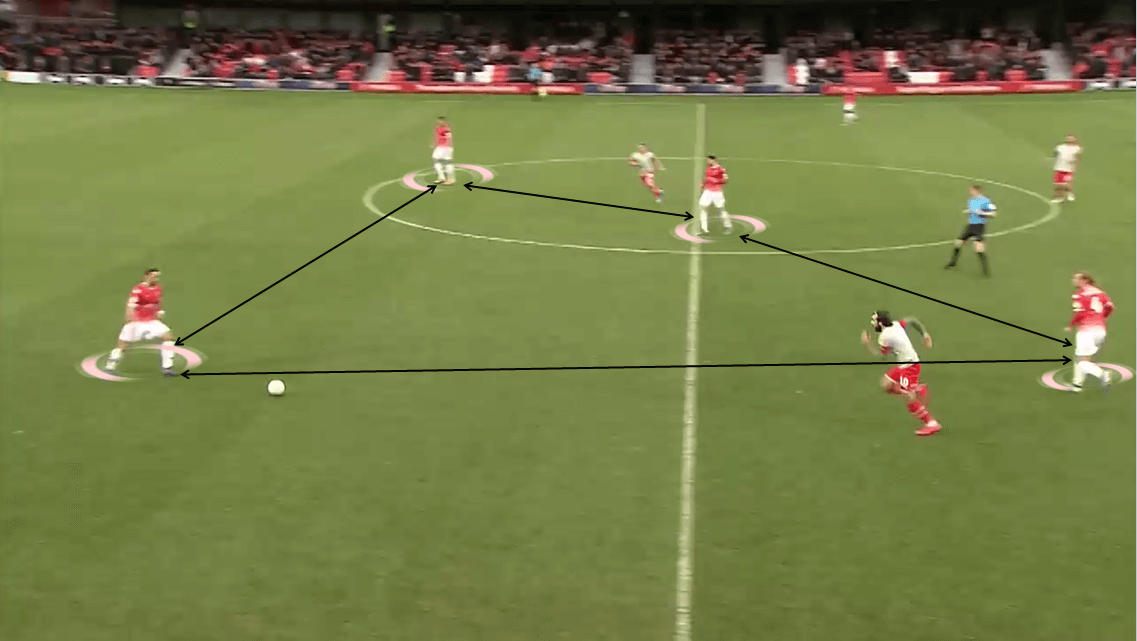
Against Swindon’s high press, the players involved in the build-up were required to circulate the ball in a quick fashion. Since the opposition’s players applied an aggressive attitude in their press, it increased the possibility of losing the ball if Salford players opted to stop the ball for a few seconds. That was when the connection between the players inside the passing block became handy.
With at least four players creating that passing block, it was possible to also create another two passing triangles among themselves. This forced the opposition to commit more players upfront to cut down passing lanes and, therefore, left gaps behind their backs for Salford players to capitalise.
Another option that both Burgess and Hogan also used was making more long balls towards the attackers. With Adam Rooney played in the role of a target man, the former Aberdeen player usually dropped quite deep from his position to pick up the ball. He would also drag along at least one of Swindon’s defenders, which opened up space for winger Jake Jervis to cut into. Using his physicality, he was able to shield the ball and then laid it off to a midfielder. From there, space would become available for him to position himself in while still able to pick up the through ball from his teammate.
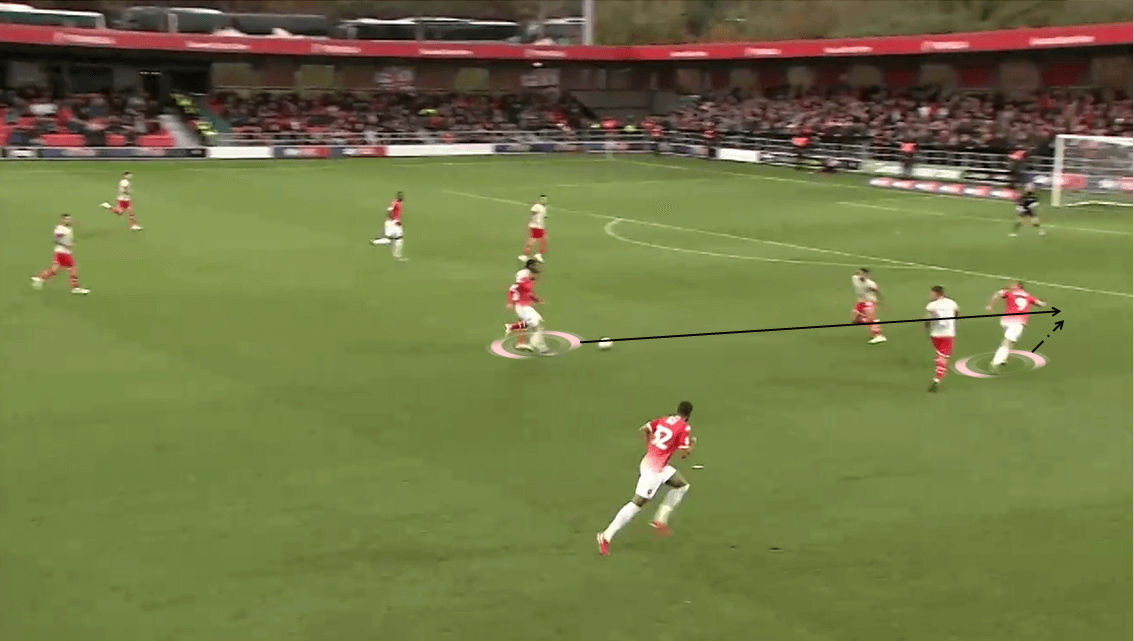
At the other end of the pitch, Swindon also liked to play out from the back using the passing ability of both Baudry and Fryers. They would create a passing block with sweeper-keeper Steven Benda and defensive midfielder Anthony Grant. Similar to Salford, both full-backs would also overlap up the pitch as the mentioned players attempted to make passes through the central area.
With Jordan Lyden pushed higher than his original position and located alongside the attacking midfielders, this changed their formation into a 4-1-4-1 in the attack. Another point to note which is Yates and Woolery tended to cut inside and worked more inside the half-spaces. They left the wide-areas for the full-backs to overlap into and if necessary, switched positions to stretch Salford’s defensive shape.
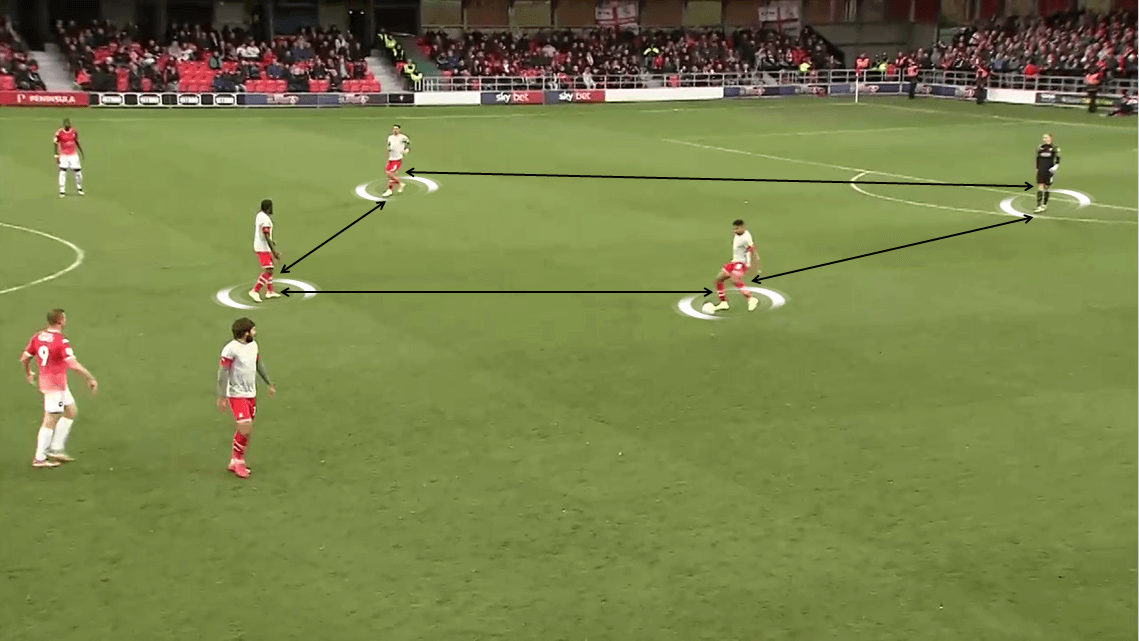
Their passing block during the build-up process was also demonstrated clearly in their passing map. One noticeable point from the graph below is Grant’s influence in the team’s transitioning process. He was the only midfielder who stayed centrally all the time as Michael Doughty opted to drift wide and even positioned himself close to striker Doyle.
Although the density of the links that the former Peterborough midfielder created wasn’t too dark, he still played a key role in the team’s build-up play. Distributing the ball was one of his duties as he managed to link up with almost every player in the team through his passes, no matter it was short-ranged or long-ranged.
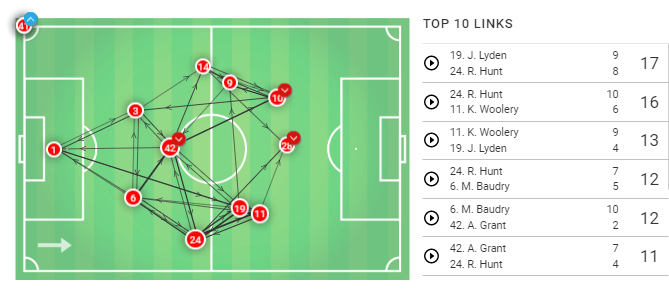
Speaking of Doughty, though, the former Queens Park Rangers player had a decent game. Statistically speaking, he registered a total of 38 passes and completed 76% of them, which made him the third-best efficient passer on the field alongside his teammates Rob Hunt and Grant respectively.
He played a key role inside the final third for Swindon, picking up passes from the midfielders and connected them to the attackers. The tendency of roaming from his position also helped him attracted the attention of Salford’s defenders, therefore, created space for his teammates to move into. But the thing that really stand out the most about him was his through passes, as demonstrated in the situation which led to Doyle’s equalising goal below.
In a system where the players were required to circulate the ball quickly, the precision of passes played a crucial role to maintain the team’s possession superiority. Doughty had the vision to pick out the teammates that he wanted his passes to head towards and inside the final third, this usually opened up great chances for the attackers. With Doyle tended to sit on the shoulder of defenders, he was able to turn up at the end of Doughty’s through balls and sprinted towards Neal’s goal for a dangerous chance. Yates and Woolery were also benefitted from his trait as they were found by Swindon’s number ten when they cut inside from both wings and entered the 16-yard box.
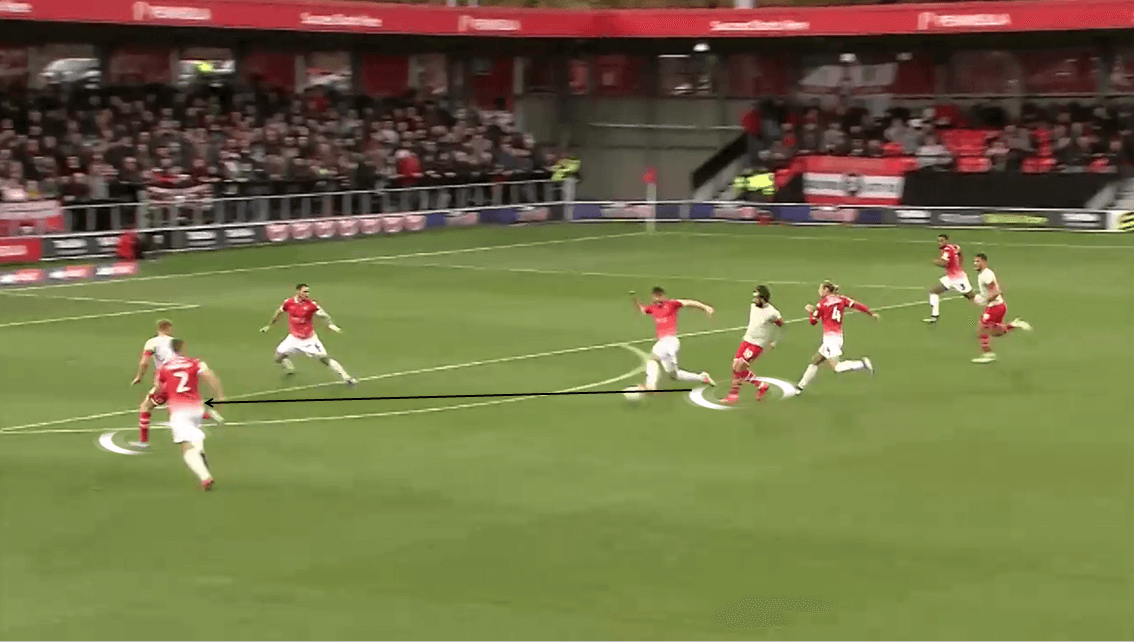
Amid the fact that one of the two goals came inside this half were from penalty kicks, the first period was more of a half where both teams attempted to find each other’s weaknesses. There were chances being created towards Neil and Benda’s goals but they all lacked the precision to create significant danger for the goalkeepers. Other than that, there weren’t many standout moments or opportunities that occurred in the first half.
A second-half which saw Swindon came out on top
In contrast to the first half, the second period brought the spectators several tactical changes to both teams’ tactics and it changed the tempo of the match significantly. Starting off with Salford as the home side aimed to press more aggressively while increasing their tempo in defence to recover possession. The players didn’t hesitate to involve in 1v1 situations and even received support from his teammates, similar to the shot below.
But committing many players into a certain area just to mark the ball carrier also left some disadvantages for Alexander’s side. One of them was pockets of space being created while the players moved out from their respective positions. In many counter-attacks, Swindon players usually found gaps where they could move into and turned up at the end of through balls. With Ibou Touray and Scott Wiseman were still recovering from their attacking positions, both flanks were left unoccupied and it invited Swindon’s wingers to capitalise that pocket of space.
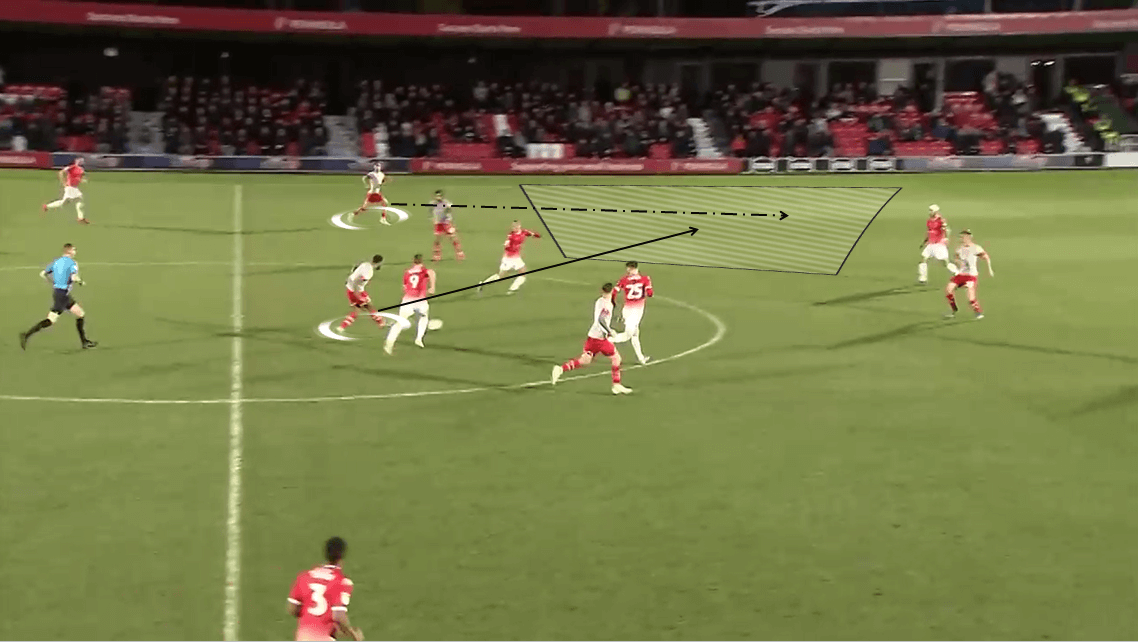
Deploying a 4-3-3 formation when out of possession was the option that Graham Alexander went with to prevent Swindon from distributing the ball wide too often. Usually, the near full-back and central midfielder would act as the focal point in creating an overload on one side of the pitch. They swarmed that flank to match with Swindon’s number while waiting for support from Threlkeld and the near centre-back.
But, again, there was a weakness that allowed Swindon to make the most out of. In the shot below, notice how far Burgess and Hogan positioned from each other and they even allowed one Swindon player to enter that gap. With just an early cross made into zone 14, it was possible for the visitor to attack the space behind Salford’s defensive line and put the mentioned player into an active state for a goal.
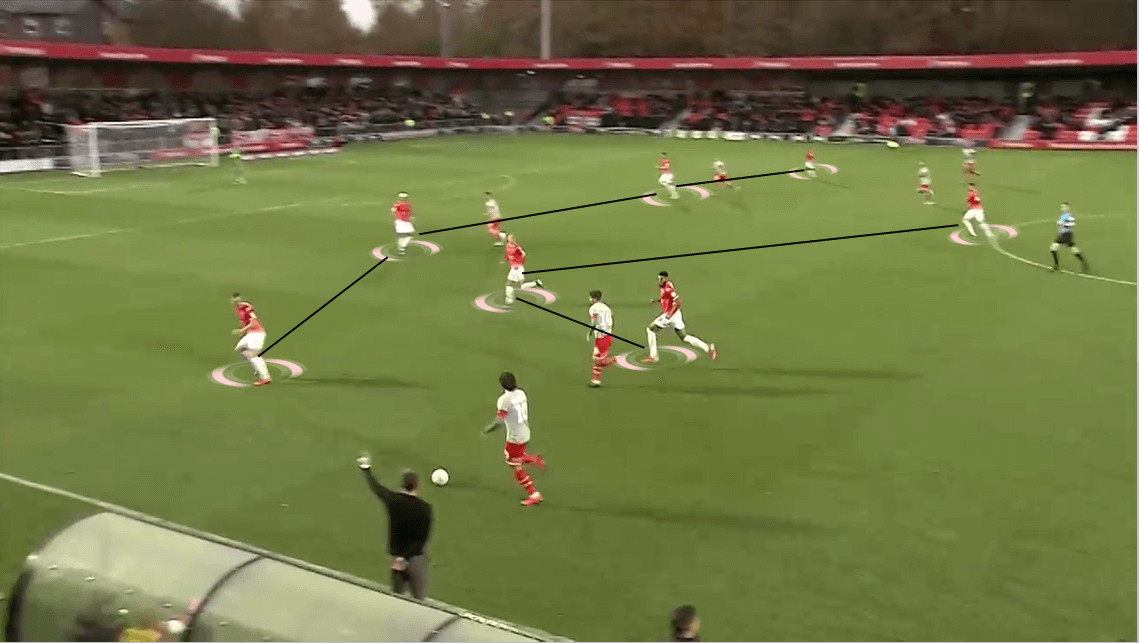
Wellens’ side also used long balls to attack the space behind Salford’s defensive line as the second half started to enter its late stage. As their opponent attempted to commit more players upfront with the hope of getting back into the game, they also left more gaps unoccupied. From the defence, a long-ranged pass could be made to the attackers and allowed them to approach the 16-yard box in a more efficient way.
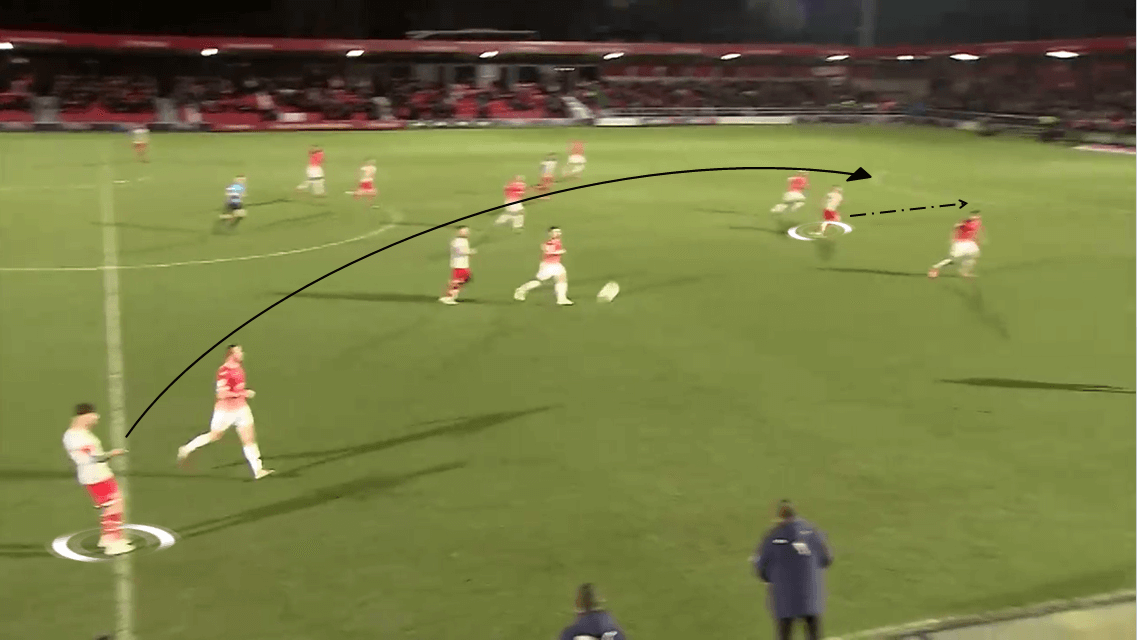
Another problem which hindered the chance of getting back into the game for Salford was their marking. The shot below indicated the situation before Yates’ goal at the 78th minute. Dealing with Swindon’s attack in this scenario, the home side opted to get more defenders occupying the edge of the box. While this allowed them to track the run of the attackers and had a clearer perspective of the situation, they also left zone 14 unoccupied for Doughty to receive the ball.
With no significant pressure from both Hogan and Threlkeld, the former Queens Park Rangers were free enough to bend his shot to the bottom left corner, which saw Neal kept it out. The 34-year-old goalkeeper also managed to prevent Doyle from completing his hat-trick by saving his rebound, but Yates’ shot later on eventually secured three points for Swindon.
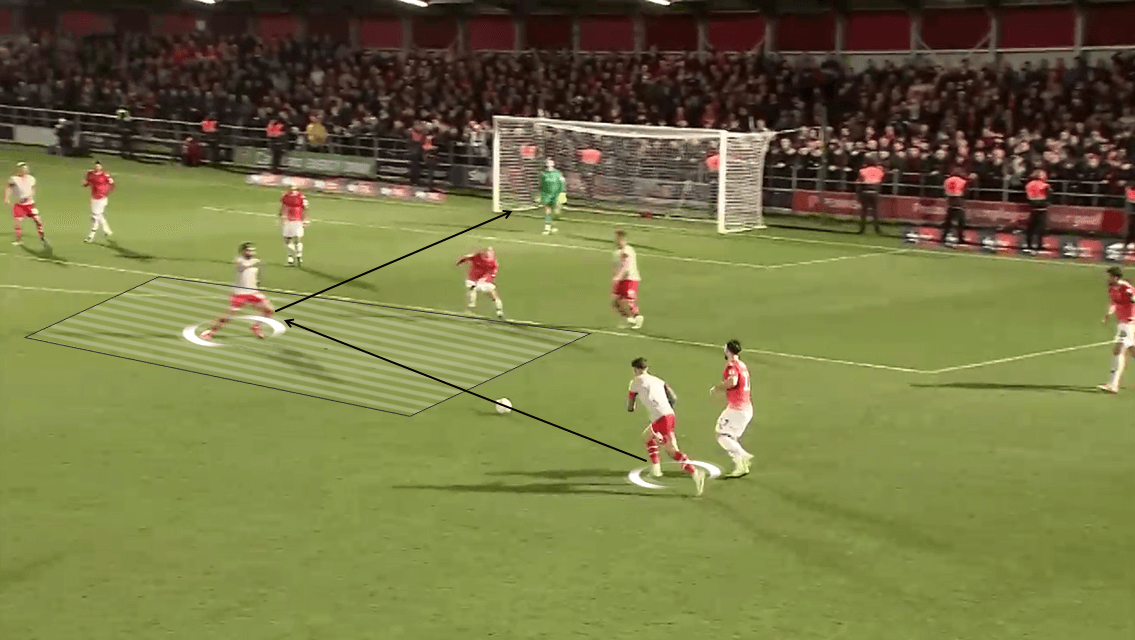
On the opposite side, Salford saw them had a better second half in terms of creating chances. Compared to only three chances being created earlier in the match, the number now being raised up to seven. But they faced one big obstacle which was low-quality chances.
As shown below, most of the created chances in between Rooney’s brace were low-rated in xG. Only Luton Town loanee Jake Jervis managed to secure a chance which was higher than 0.2 in the stoppage time of the second half. This showed the low efficiency in their chances and they lacked precision being emphasised throughout the match.
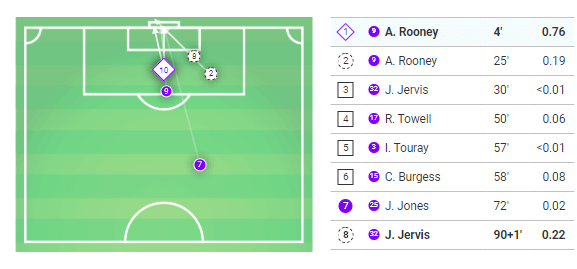
As Swindon used a 4-2-3-1 defensive shape and even aimed to stretch wide more often, this prevented Salford from executing their plan of exploiting both flanks. They also found themselves struggled to progress the ball into the central area with Grant and Lyden managed to screen the space in front of the defensive line. They were responsible for intercepting passes that came towards them and shifting towards both flanks to help the full-backs in recovering possession for the team.
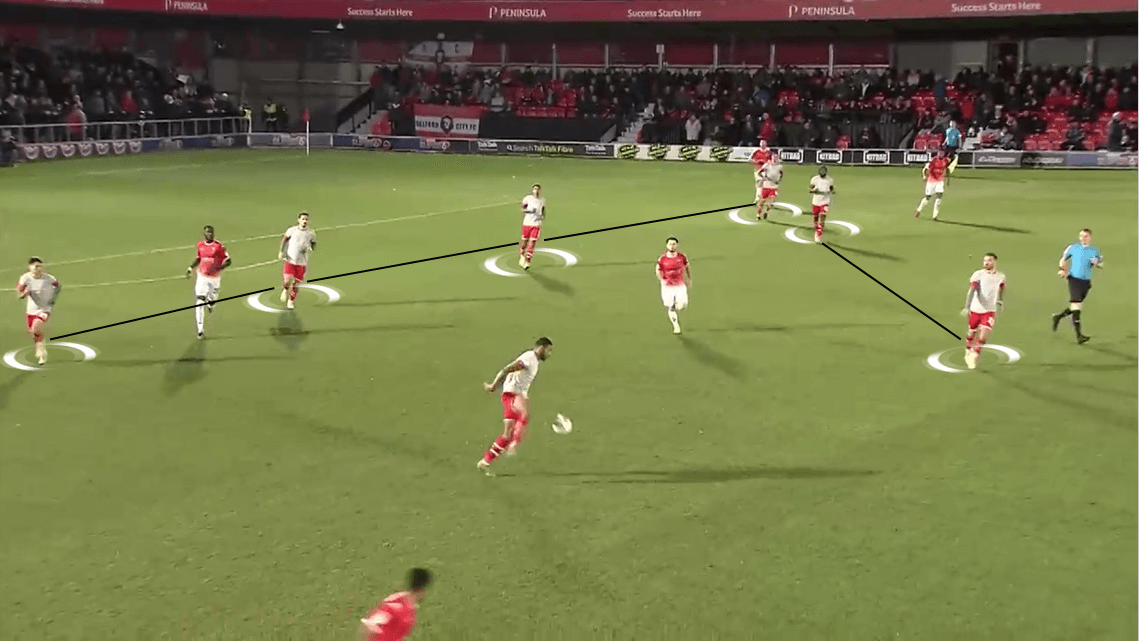
Conclusion
As much as Salford tried to recover their lead, Swindon enjoyed a very efficient half in terms of defending and creating chances. The away side secured two goals in two crucial stages of the half, which allowed them to be more confident in controlling the match.
Salford, on the other hand, found themselves on the back foot during most of the time as they didn’t enjoy much of the possession and with the precision-lacking problem in their chances, it hindered their progress of finding that equalising goal before the whistle was blown. Adam Rooney’s late penalty wasn’t enough to at least save one point at the Peninsula Stadium as the away side came away with joy and even better, secured the top spot with Forest Green Rovers fell short against Plymouth Argyle.

If you love tactical analysis, then you’ll love the digital magazines from totalfootballanalysis.com – a guaranteed 100+ pages of pure tactical analysis covering topics from the Premier League, Serie A, La Liga, Bundesliga and many, many more. Buy your copy of the November issue for just ₤4.99 here




Comments